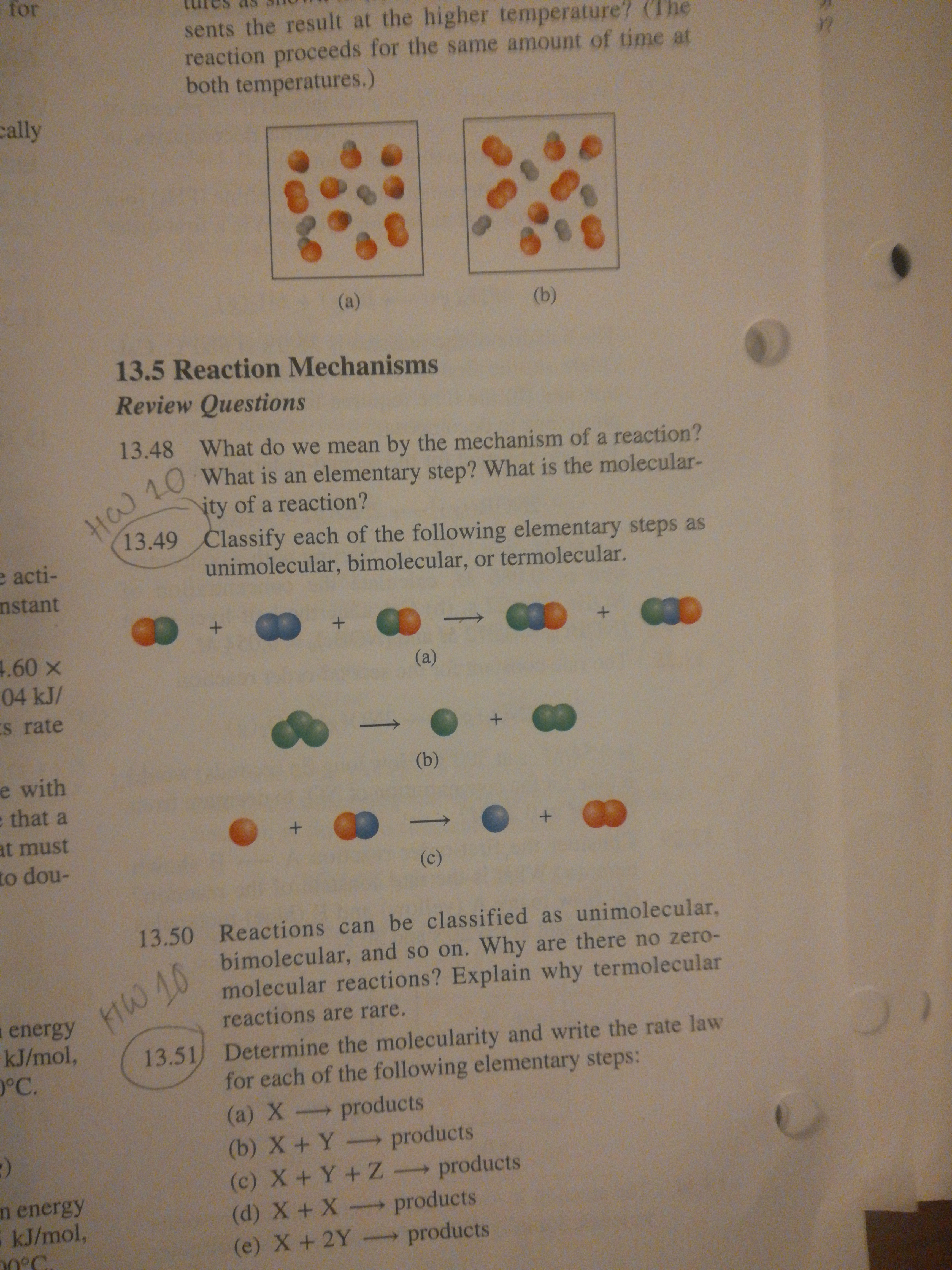for sents the result at the higher temperature' (The reaction proceeds for the same amount of time at both temperatures.) cally (a) (b) 13.5 Reaction Mechanisms Review Questions 13.48 What do we mean by the mechanism of a reaction? H 10 What is an elementary step? What is the molecular- ity of a reaction? 13.49 Classify each of the following elementary steps as e acti- nstant unimolecular, bimolecular, or termolecular. 4.60 x (a) 04 kJ/ Es rate (b) e with e that a +. at must to dou- (c) 13.50 Reactions can be classified as unimolecular, bimolecular, and so on. Why are there no zero- molecular reactions? Explain why termolecular reactions are rare. MW 10 a energy kJ/mol, °C. 13.51) Determine the molecularity and write the rate law for each of the following elementary steps: (a) X products (b) X+Y- products (c) X+ Y+Z products (d) X +X products (e) X+2Y products n energy 5 kJ/mol, 0°C
for sents the result at the higher temperature' (The reaction proceeds for the same amount of time at both temperatures.) cally (a) (b) 13.5 Reaction Mechanisms Review Questions 13.48 What do we mean by the mechanism of a reaction? H 10 What is an elementary step? What is the molecular- ity of a reaction? 13.49 Classify each of the following elementary steps as e acti- nstant unimolecular, bimolecular, or termolecular. 4.60 x (a) 04 kJ/ Es rate (b) e with e that a +. at must to dou- (c) 13.50 Reactions can be classified as unimolecular, bimolecular, and so on. Why are there no zero- molecular reactions? Explain why termolecular reactions are rare. MW 10 a energy kJ/mol, °C. 13.51) Determine the molecularity and write the rate law for each of the following elementary steps: (a) X products (b) X+Y- products (c) X+ Y+Z products (d) X +X products (e) X+2Y products n energy 5 kJ/mol, 0°C
Introduction to General, Organic and Biochemistry
11th Edition
ISBN:9781285869759
Author:Frederick A. Bettelheim, William H. Brown, Mary K. Campbell, Shawn O. Farrell, Omar Torres
Publisher:Frederick A. Bettelheim, William H. Brown, Mary K. Campbell, Shawn O. Farrell, Omar Torres
Chapter7: Reaction Rates And Chemical Equilibrium
Section: Chapter Questions
Problem 7.59P
Related questions
Question
13.49

Transcribed Image Text:for
sents the result at the higher temperature' (The
reaction proceeds for the same amount of time at
both temperatures.)
cally
(a)
(b)
13.5 Reaction Mechanisms
Review Questions
13.48 What do we mean by the mechanism of a reaction?
H 10 What is an elementary step? What is the molecular-
ity of a reaction?
13.49 Classify each of the following elementary steps as
e acti-
nstant
unimolecular, bimolecular, or termolecular.
4.60 x
(a)
04 kJ/
Es rate
(b)
e with
e that a
+.
at must
to dou-
(c)
13.50 Reactions can be classified as unimolecular,
bimolecular, and so on. Why are there no zero-
molecular reactions? Explain why termolecular
reactions are rare.
MW 10
a energy
kJ/mol,
°C.
13.51) Determine the molecularity and write the rate law
for each of the following elementary steps:
(a) X products
(b) X+Y- products
(c) X+ Y+Z products
(d) X +X products
(e) X+2Y products
n energy
5 kJ/mol,
0°C
Expert Solution
This question has been solved!
Explore an expertly crafted, step-by-step solution for a thorough understanding of key concepts.
This is a popular solution!
Trending now
This is a popular solution!
Step by step
Solved in 2 steps

Knowledge Booster
Learn more about
Need a deep-dive on the concept behind this application? Look no further. Learn more about this topic, chemistry and related others by exploring similar questions and additional content below.Recommended textbooks for you

Introduction to General, Organic and Biochemistry
Chemistry
ISBN:
9781285869759
Author:
Frederick A. Bettelheim, William H. Brown, Mary K. Campbell, Shawn O. Farrell, Omar Torres
Publisher:
Cengage Learning

Principles of Modern Chemistry
Chemistry
ISBN:
9781305079113
Author:
David W. Oxtoby, H. Pat Gillis, Laurie J. Butler
Publisher:
Cengage Learning

Chemistry by OpenStax (2015-05-04)
Chemistry
ISBN:
9781938168390
Author:
Klaus Theopold, Richard H Langley, Paul Flowers, William R. Robinson, Mark Blaser
Publisher:
OpenStax

Introduction to General, Organic and Biochemistry
Chemistry
ISBN:
9781285869759
Author:
Frederick A. Bettelheim, William H. Brown, Mary K. Campbell, Shawn O. Farrell, Omar Torres
Publisher:
Cengage Learning

Principles of Modern Chemistry
Chemistry
ISBN:
9781305079113
Author:
David W. Oxtoby, H. Pat Gillis, Laurie J. Butler
Publisher:
Cengage Learning

Chemistry by OpenStax (2015-05-04)
Chemistry
ISBN:
9781938168390
Author:
Klaus Theopold, Richard H Langley, Paul Flowers, William R. Robinson, Mark Blaser
Publisher:
OpenStax

Chemistry: Principles and Reactions
Chemistry
ISBN:
9781305079373
Author:
William L. Masterton, Cecile N. Hurley
Publisher:
Cengage Learning

Chemistry & Chemical Reactivity
Chemistry
ISBN:
9781133949640
Author:
John C. Kotz, Paul M. Treichel, John Townsend, David Treichel
Publisher:
Cengage Learning

Chemistry for Engineering Students
Chemistry
ISBN:
9781337398909
Author:
Lawrence S. Brown, Tom Holme
Publisher:
Cengage Learning